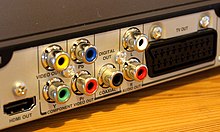DVD player
A DVD player (also known as a DVD player or often a DVD player ) is a player for video DVDs . The successor is the Blu-ray player .
function

DVD players are specially designed for playing videos on a DVD data carrier and are usually connected to a television set . DVD players are downward compatible with CD players , so they can also play normal audio CDs . It is often forgotten that there is a different type of player for DVD-Audio , also called a DVD player.
Depending on the equipment, current devices can play VCDs and SVCDs as well as highly compressed films in DivX , Xvid , MP4 , Nero Digital or WMV9 format. Newer DVD players can also play music in MP3 and / or WMA format and display image files in JPEG format. Many DVD players can only play DVDs marked with regional codes if they are marked with the same regional code. B. in Malaysia also so-called "region-free players", which ignore this marking and play all DVDs.
DVD players for Europe are equipped with a SCART connection, in the rest of the world with cinch sockets for composite video (yellow) and analog audio (red and white), some also with SCART and the cinch sockets, some DVD players in addition, also with S-Video or the Component Video or HDMI connections, which are also suitable for higher resolution . Some have connections for USB storage devices and the most popular memory cards and can play data from these media.
After Blu-ray players and the PlayStation 3 that can play DVDs with the AVCHD format have been on the market for years , DVD players that support this format will soon come onto the market. Other so-called “universal players” also master audio media such as SACD (Super Audio Compact Disc) or DVD-Audio , which offer better quality than conventional CDs, which is why they are particularly found in high-quality audio systems or home theaters . More exotic DVD players can also receive and play video streams from the PC via Ethernet or WLAN .
volume
In addition to the SCART output, DVD players usually have an analog two-channel cinch output and a downmix function for sound output . This means that if the media has Dolby Digital , Dolby Surround or other multi-channel sound formats, it can be distributed over two stereo channels (also via the SCART output).
Newer DVD player with built-in surround decoder have usually a so-called six-channel connection or 5.1 output, recognizable by six individual RCA all connections, with , front, right, subwoofer, center, surround left, surround right Front left are designated . With the appropriate cables, a connection to the 5.1 input of an AV receiver provided for this purpose is possible in order to be able to reproduce surround sound.
Some devices also have an optical or coaxial digital output. With the appropriate digital cables, they can be connected to an appropriately equipped AV receiver, which also enables surround sound playback.
Executions
DVD players are available in different versions:
- Single device ( stand-alone )
- The compact combination of AV receiver and DVD player is known as a DVD receiver .
- A portable device, e.g. B. with a small LCD ( portable DVD or TV-DVD combination ).
- Integrated with other devices ( cars or game consoles such as Sony's PlayStation 2 ).
- As a function of a PC with a built-in DVD drive ( DVD-ROM or burner ) together with media player software and a codec suitable for the file format .
- Blu-ray disc players: These are usually backwards compatible so that they can also be used as DVD players.
- Karaoke DVD players: These have adjustable microphone inputs and can play CD + Gs (graphic CDs).
history
The first DVD players - which could of course also play audio CDs - initially only came onto the market in Japan in November 1996 and cost the equivalent of around € 700 to € 900, in the USA they were then sold in March 1997 - initially only in 7 major cities - sold, then in late 1997 all over the US. DVD players only came onto the market in Europe in 1998 and in Australia in 1999. The drop in prices for DVD players, which was observed from the outset, accelerated further when the PlayStation 2 game console from Sony was launched worldwide in November 2000 , as this device can also play DVDs. In 1999 a DVD player cost around € 500 in German-speaking countries, but inexpensive devices are now available for prices starting at € 30.
The company Pioneer sold from November 1996 (three weeks after the first DVD player) in Japan, the first DVD / LD / VCD / CD combination player models, both laser discs can play as well as DVDs. The first model was the DVL-700 , at the time it cost around US $ 1200. The last model DVL-919 was built from 1999 to 2009 and cost around 900 euros. In 1999 there was also a version DVL-919E for the European market that supports PAL and NTSC.
In 2011, 37.14 million people in Germany already had a DVD player in their household. This number excludes the PlayStation 2, of which 154 million were sold worldwide between 2000 and 2012.
DVD player games
A DVD player can also be used to play so-called DVD player games that are operated with the DVD player remote control. These types of games are mostly set in the quiz area (e.g. Who Wants to be a Millionaire? ). However, these can damage the drive in the long run, as the laser has to constantly jump back and forth on the DVD. The player drives are not designed for this.
See also
Individual evidence
- ↑ http://www.pavtube.com/dvd/dvd_player_history.html
- ↑ DVD Information. Accessed December 5, 2012.

